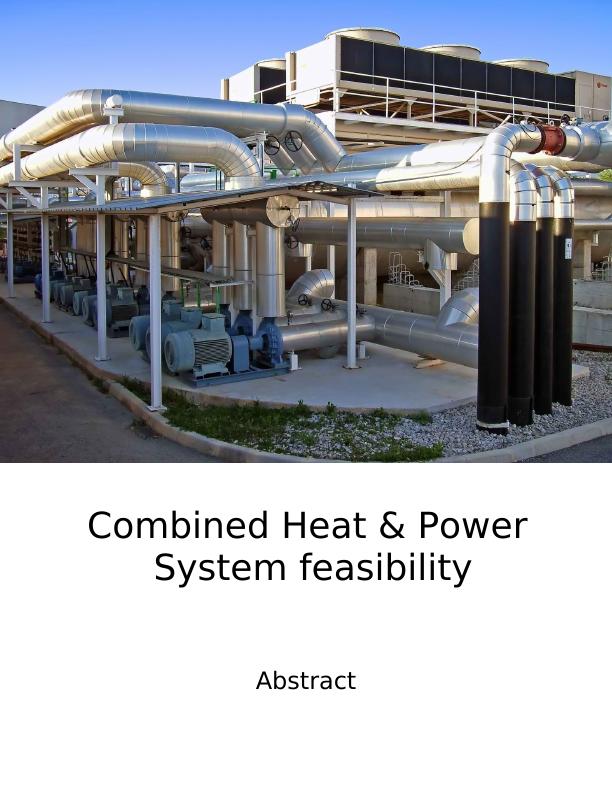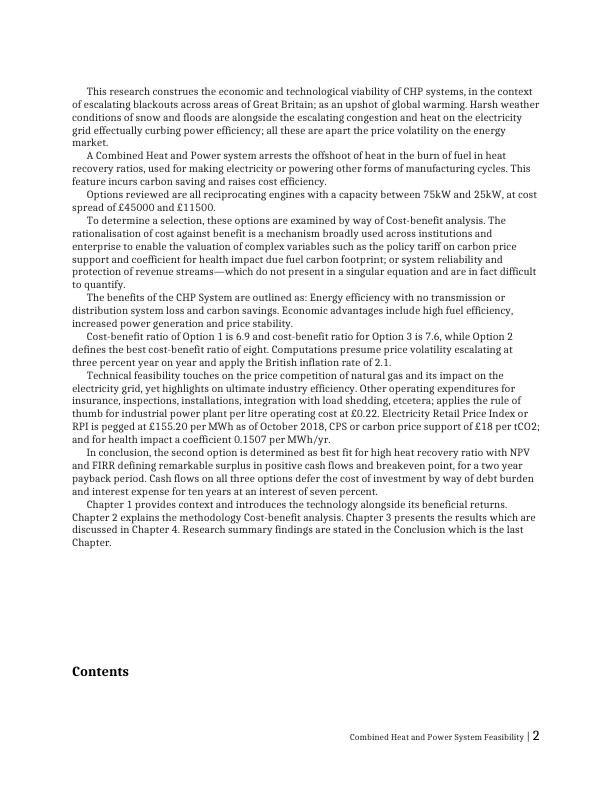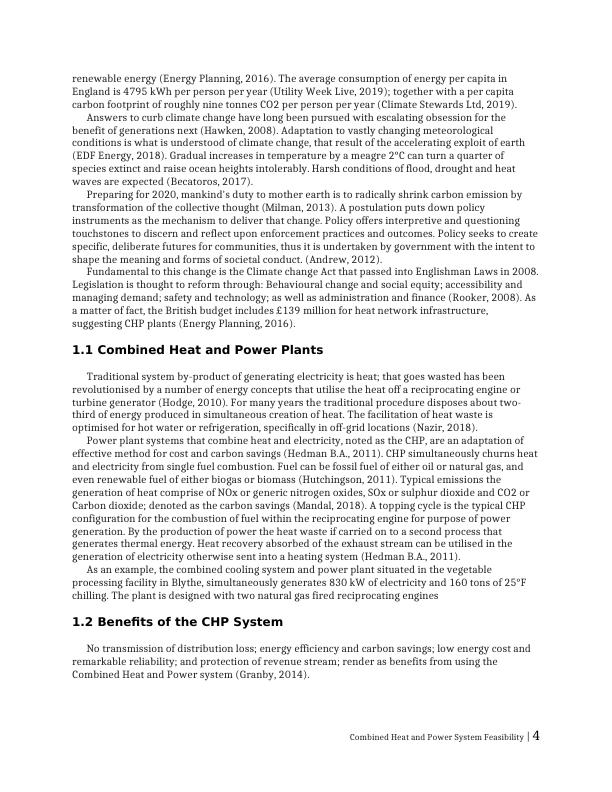Combined Heat & Power System Feasibility
Assess the technical and financial feasibility of installing a CHP plant, considering its viability, impact of discount rate, and the effect of natural gas and grid electricity prices on economic viability, energy savings, cost savings, and CO2 emissions.
14 Pages5471 Words107 Views
Added on 2023-04-21
About This Document
This research explores the economic and technological viability of CHP systems in the context of escalating blackouts across areas of Great Britain due to global warming. It discusses the benefits of CHP systems, options for reciprocating engines, and the methodology of cost-benefit analysis. The results show the best option for high heat recovery ratio and positive cash flows. The document also provides an introduction to CHP plants and their benefits.
Combined Heat & Power System Feasibility
Assess the technical and financial feasibility of installing a CHP plant, considering its viability, impact of discount rate, and the effect of natural gas and grid electricity prices on economic viability, energy savings, cost savings, and CO2 emissions.
Added on 2023-04-21
ShareRelated Documents
Combined Heat & Power
System feasibility
Abstract
System feasibility
Abstract

This research construes the economic and technological viability of CHP systems, in the context
of escalating blackouts across areas of Great Britain; as an upshot of global warming. Harsh weather
conditions of snow and floods are alongside the escalating congestion and heat on the electricity
grid effectually curbing power efficiency; all these are apart the price volatility on the energy
market.
A Combined Heat and Power system arrests the offshoot of heat in the burn of fuel in heat
recovery ratios, used for making electricity or powering other forms of manufacturing cycles. This
feature incurs carbon saving and raises cost efficiency.
Options reviewed are all reciprocating engines with a capacity between 75kW and 25kW, at cost
spread of £45000 and £11500.
To determine a selection, these options are examined by way of Cost-benefit analysis. The
rationalisation of cost against benefit is a mechanism broadly used across institutions and
enterprise to enable the valuation of complex variables such as the policy tariff on carbon price
support and coefficient for health impact due fuel carbon footprint; or system reliability and
protection of revenue streams—which do not present in a singular equation and are in fact difficult
to quantify.
The benefits of the CHP System are outlined as: Energy efficiency with no transmission or
distribution system loss and carbon savings. Economic advantages include high fuel efficiency,
increased power generation and price stability.
Cost-benefit ratio of Option 1 is 6.9 and cost-benefit ratio for Option 3 is 7.6, while Option 2
defines the best cost-benefit ratio of eight. Computations presume price volatility escalating at
three percent year on year and apply the British inflation rate of 2.1.
Technical feasibility touches on the price competition of natural gas and its impact on the
electricity grid, yet highlights on ultimate industry efficiency. Other operating expenditures for
insurance, inspections, installations, integration with load shedding, etcetera; applies the rule of
thumb for industrial power plant per litre operating cost at £0.22. Electricity Retail Price Index or
RPI is pegged at £155.20 per MWh as of October 2018, CPS or carbon price support of £18 per tCO2;
and for health impact a coefficient 0.1507 per MWh/yr.
In conclusion, the second option is determined as best fit for high heat recovery ratio with NPV
and FIRR defining remarkable surplus in positive cash flows and breakeven point, for a two year
payback period. Cash flows on all three options defer the cost of investment by way of debt burden
and interest expense for ten years at an interest of seven percent.
Chapter 1 provides context and introduces the technology alongside its beneficial returns.
Chapter 2 explains the methodology Cost-benefit analysis. Chapter 3 presents the results which are
discussed in Chapter 4. Research summary findings are stated in the Conclusion which is the last
Chapter.
Contents
Combined Heat and Power System Feasibility | 2
of escalating blackouts across areas of Great Britain; as an upshot of global warming. Harsh weather
conditions of snow and floods are alongside the escalating congestion and heat on the electricity
grid effectually curbing power efficiency; all these are apart the price volatility on the energy
market.
A Combined Heat and Power system arrests the offshoot of heat in the burn of fuel in heat
recovery ratios, used for making electricity or powering other forms of manufacturing cycles. This
feature incurs carbon saving and raises cost efficiency.
Options reviewed are all reciprocating engines with a capacity between 75kW and 25kW, at cost
spread of £45000 and £11500.
To determine a selection, these options are examined by way of Cost-benefit analysis. The
rationalisation of cost against benefit is a mechanism broadly used across institutions and
enterprise to enable the valuation of complex variables such as the policy tariff on carbon price
support and coefficient for health impact due fuel carbon footprint; or system reliability and
protection of revenue streams—which do not present in a singular equation and are in fact difficult
to quantify.
The benefits of the CHP System are outlined as: Energy efficiency with no transmission or
distribution system loss and carbon savings. Economic advantages include high fuel efficiency,
increased power generation and price stability.
Cost-benefit ratio of Option 1 is 6.9 and cost-benefit ratio for Option 3 is 7.6, while Option 2
defines the best cost-benefit ratio of eight. Computations presume price volatility escalating at
three percent year on year and apply the British inflation rate of 2.1.
Technical feasibility touches on the price competition of natural gas and its impact on the
electricity grid, yet highlights on ultimate industry efficiency. Other operating expenditures for
insurance, inspections, installations, integration with load shedding, etcetera; applies the rule of
thumb for industrial power plant per litre operating cost at £0.22. Electricity Retail Price Index or
RPI is pegged at £155.20 per MWh as of October 2018, CPS or carbon price support of £18 per tCO2;
and for health impact a coefficient 0.1507 per MWh/yr.
In conclusion, the second option is determined as best fit for high heat recovery ratio with NPV
and FIRR defining remarkable surplus in positive cash flows and breakeven point, for a two year
payback period. Cash flows on all three options defer the cost of investment by way of debt burden
and interest expense for ten years at an interest of seven percent.
Chapter 1 provides context and introduces the technology alongside its beneficial returns.
Chapter 2 explains the methodology Cost-benefit analysis. Chapter 3 presents the results which are
discussed in Chapter 4. Research summary findings are stated in the Conclusion which is the last
Chapter.
Contents
Combined Heat and Power System Feasibility | 2

Abstract....................................................................................................................................................................................... 2
1.Introduction.............................................................................................................................................................................. 3
1.1 Combined Heat and Power Plants....................................................................................................................4
1.2 Benefits of the CHP System..................................................................................................................................4
1.2.1 Energy efficiency............................................................................................................................................. 5
1.2.2 No transmission or distribution loss......................................................................................................5
1.2.3 Carbon savings................................................................................................................................................. 5
1.2.4 Economic advantage......................................................................................................................................5
1.2.5 Protection of revenue streams..................................................................................................................5
2.Methodology............................................................................................................................................................................. 5
3.Results......................................................................................................................................................................................... 6
3.1 Debt burden...........................................................................................................................................................6
3.2 Carbon Price Support........................................................................................................................................6
3.3 Coefficient for Health Impact.........................................................................................................................6
3.4 Electricity Retail Price Index..........................................................................................................................7
3.5 Country Inflation Rate.......................................................................................................................................7
3.6 Other Operating Expenditure........................................................................................................................7
Option 1 Reciprocating Engine 75 kW CHP Capacity......................................................................................8
Option 2 Reciprocating Engine 50 kW CHP Capacity......................................................................................9
Option 3 Reciprocating Engine 25 kW CHP Capacity...................................................................................10
4. Discussion............................................................................................................................................................................... 11
Net Present value..........................................................................................................................................................11
Technical viability........................................................................................................................................................ 12
Industrial efficiency................................................................................................................................................ 12
Natural Gas Prices and Grid electricity...............................................................................................................13
5.Conclusion............................................................................................................................................................................... 13
1. Introduction
England's Government is in frenzy search of innovative methods to deliver energy that is
affordable, sustainable and secure. Policy emphasis for new developments emphasis: ‘Be lean—be
clean—be green’, would mean using less energy, institutionalising energy efficiency and using
Combined Heat and Power System Feasibility | 3
1.Introduction.............................................................................................................................................................................. 3
1.1 Combined Heat and Power Plants....................................................................................................................4
1.2 Benefits of the CHP System..................................................................................................................................4
1.2.1 Energy efficiency............................................................................................................................................. 5
1.2.2 No transmission or distribution loss......................................................................................................5
1.2.3 Carbon savings................................................................................................................................................. 5
1.2.4 Economic advantage......................................................................................................................................5
1.2.5 Protection of revenue streams..................................................................................................................5
2.Methodology............................................................................................................................................................................. 5
3.Results......................................................................................................................................................................................... 6
3.1 Debt burden...........................................................................................................................................................6
3.2 Carbon Price Support........................................................................................................................................6
3.3 Coefficient for Health Impact.........................................................................................................................6
3.4 Electricity Retail Price Index..........................................................................................................................7
3.5 Country Inflation Rate.......................................................................................................................................7
3.6 Other Operating Expenditure........................................................................................................................7
Option 1 Reciprocating Engine 75 kW CHP Capacity......................................................................................8
Option 2 Reciprocating Engine 50 kW CHP Capacity......................................................................................9
Option 3 Reciprocating Engine 25 kW CHP Capacity...................................................................................10
4. Discussion............................................................................................................................................................................... 11
Net Present value..........................................................................................................................................................11
Technical viability........................................................................................................................................................ 12
Industrial efficiency................................................................................................................................................ 12
Natural Gas Prices and Grid electricity...............................................................................................................13
5.Conclusion............................................................................................................................................................................... 13
1. Introduction
England's Government is in frenzy search of innovative methods to deliver energy that is
affordable, sustainable and secure. Policy emphasis for new developments emphasis: ‘Be lean—be
clean—be green’, would mean using less energy, institutionalising energy efficiency and using
Combined Heat and Power System Feasibility | 3

renewable energy (Energy Planning, 2016). The average consumption of energy per capita in
England is 4795 kWh per person per year (Utility Week Live, 2019); together with a per capita
carbon footprint of roughly nine tonnes CO2 per person per year (Climate Stewards Ltd, 2019).
Answers to curb climate change have long been pursued with escalating obsession for the
benefit of generations next (Hawken, 2008). Adaptation to vastly changing meteorological
conditions is what is understood of climate change, that result of the accelerating exploit of earth
(EDF Energy, 2018). Gradual increases in temperature by a meagre 2°C can turn a quarter of
species extinct and raise ocean heights intolerably. Harsh conditions of flood, drought and heat
waves are expected (Becatoros, 2017).
Preparing for 2020, mankind's duty to mother earth is to radically shrink carbon emission by
transformation of the collective thought (Milman, 2013). A postulation puts down policy
instruments as the mechanism to deliver that change. Policy offers interpretive and questioning
touchstones to discern and reflect upon enforcement practices and outcomes. Policy seeks to create
specific, deliberate futures for communities, thus it is undertaken by government with the intent to
shape the meaning and forms of societal conduct. (Andrew, 2012).
Fundamental to this change is the Climate change Act that passed into Englishman Laws in 2008.
Legislation is thought to reform through: Behavioural change and social equity; accessibility and
managing demand; safety and technology; as well as administration and finance (Rooker, 2008). As
a matter of fact, the British budget includes £139 million for heat network infrastructure,
suggesting CHP plants (Energy Planning, 2016).
1.1 Combined Heat and Power Plants
Traditional system by-product of generating electricity is heat; that goes wasted has been
revolutionised by a number of energy concepts that utilise the heat off a reciprocating engine or
turbine generator (Hodge, 2010). For many years the traditional procedure disposes about two-
third of energy produced in simultaneous creation of heat. The facilitation of heat waste is
optimised for hot water or refrigeration, specifically in off-grid locations (Nazir, 2018).
Power plant systems that combine heat and electricity, noted as the CHP, are an adaptation of
effective method for cost and carbon savings (Hedman B.A., 2011). CHP simultaneously churns heat
and electricity from single fuel combustion. Fuel can be fossil fuel of either oil or natural gas, and
even renewable fuel of either biogas or biomass (Hutchingson, 2011). Typical emissions the
generation of heat comprise of NOx or generic nitrogen oxides, SOx or sulphur dioxide and CO2 or
Carbon dioxide; denoted as the carbon savings (Mandal, 2018). A topping cycle is the typical CHP
configuration for the combustion of fuel within the reciprocating engine for purpose of power
generation. By the production of power the heat waste if carried on to a second process that
generates thermal energy. Heat recovery absorbed of the exhaust stream can be utilised in the
generation of electricity otherwise sent into a heating system (Hedman B.A., 2011).
As an example, the combined cooling system and power plant situated in the vegetable
processing facility in Blythe, simultaneously generates 830 kW of electricity and 160 tons of 25°F
chilling. The plant is designed with two natural gas fired reciprocating engines
1.2 Benefits of the CHP System
No transmission of distribution loss; energy efficiency and carbon savings; low energy cost and
remarkable reliability; and protection of revenue stream; render as benefits from using the
Combined Heat and Power system (Granby, 2014).
Combined Heat and Power System Feasibility | 4
England is 4795 kWh per person per year (Utility Week Live, 2019); together with a per capita
carbon footprint of roughly nine tonnes CO2 per person per year (Climate Stewards Ltd, 2019).
Answers to curb climate change have long been pursued with escalating obsession for the
benefit of generations next (Hawken, 2008). Adaptation to vastly changing meteorological
conditions is what is understood of climate change, that result of the accelerating exploit of earth
(EDF Energy, 2018). Gradual increases in temperature by a meagre 2°C can turn a quarter of
species extinct and raise ocean heights intolerably. Harsh conditions of flood, drought and heat
waves are expected (Becatoros, 2017).
Preparing for 2020, mankind's duty to mother earth is to radically shrink carbon emission by
transformation of the collective thought (Milman, 2013). A postulation puts down policy
instruments as the mechanism to deliver that change. Policy offers interpretive and questioning
touchstones to discern and reflect upon enforcement practices and outcomes. Policy seeks to create
specific, deliberate futures for communities, thus it is undertaken by government with the intent to
shape the meaning and forms of societal conduct. (Andrew, 2012).
Fundamental to this change is the Climate change Act that passed into Englishman Laws in 2008.
Legislation is thought to reform through: Behavioural change and social equity; accessibility and
managing demand; safety and technology; as well as administration and finance (Rooker, 2008). As
a matter of fact, the British budget includes £139 million for heat network infrastructure,
suggesting CHP plants (Energy Planning, 2016).
1.1 Combined Heat and Power Plants
Traditional system by-product of generating electricity is heat; that goes wasted has been
revolutionised by a number of energy concepts that utilise the heat off a reciprocating engine or
turbine generator (Hodge, 2010). For many years the traditional procedure disposes about two-
third of energy produced in simultaneous creation of heat. The facilitation of heat waste is
optimised for hot water or refrigeration, specifically in off-grid locations (Nazir, 2018).
Power plant systems that combine heat and electricity, noted as the CHP, are an adaptation of
effective method for cost and carbon savings (Hedman B.A., 2011). CHP simultaneously churns heat
and electricity from single fuel combustion. Fuel can be fossil fuel of either oil or natural gas, and
even renewable fuel of either biogas or biomass (Hutchingson, 2011). Typical emissions the
generation of heat comprise of NOx or generic nitrogen oxides, SOx or sulphur dioxide and CO2 or
Carbon dioxide; denoted as the carbon savings (Mandal, 2018). A topping cycle is the typical CHP
configuration for the combustion of fuel within the reciprocating engine for purpose of power
generation. By the production of power the heat waste if carried on to a second process that
generates thermal energy. Heat recovery absorbed of the exhaust stream can be utilised in the
generation of electricity otherwise sent into a heating system (Hedman B.A., 2011).
As an example, the combined cooling system and power plant situated in the vegetable
processing facility in Blythe, simultaneously generates 830 kW of electricity and 160 tons of 25°F
chilling. The plant is designed with two natural gas fired reciprocating engines
1.2 Benefits of the CHP System
No transmission of distribution loss; energy efficiency and carbon savings; low energy cost and
remarkable reliability; and protection of revenue stream; render as benefits from using the
Combined Heat and Power system (Granby, 2014).
Combined Heat and Power System Feasibility | 4

End of preview
Want to access all the pages? Upload your documents or become a member.
Related Documents
Low Carbon District Heating Using Combined Heat and Power in U.Slg...
|21
|5343
|41
Chp Modelling Assignment PDFlg...
|20
|5693
|83
Management Development and Innovationlg...
|13
|1734
|97
Feasibility Analysis of Hybrid Energy System for Scone Regionlg...
|18
|4543
|156
